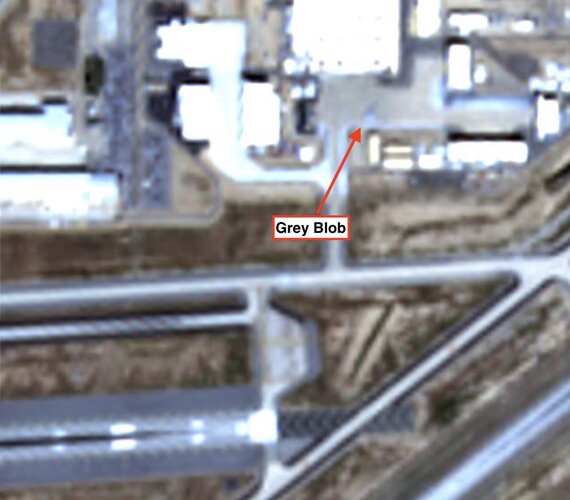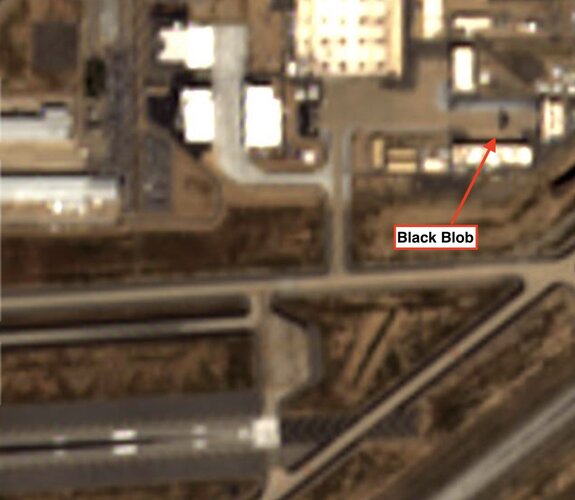You are using an out of date browser. It may not display this or other websites correctly.
You should upgrade or use an alternative browser.
You should upgrade or use an alternative browser.
Northrop Grumman B-21 Raider (LRS-B)
- Thread starter TomS
- Start date
- Joined
- 1 April 2006
- Messages
- 11,373
- Reaction score
- 10,198
I thought it was clear in last December that not.I think it's still got the B-2 "Toothpick" LE shape...
Attachments
- Joined
- 1 April 2006
- Messages
- 11,373
- Reaction score
- 10,198
Just thought that this angle rules off theories about distributed 'platypus' F-117A-like nozzle...
X-39
To post or not to post, that is the question
- Joined
- 20 February 2021
- Messages
- 382
- Reaction score
- 928

What Does A Former B-2 Pilot See In Photos Of The B-21 Raider?
I asked Robert Spaulding, former commander of the Air Force’s B-2 Stealth Bomber unit, what photos of the B-21 tell us.
 www.forbes.com
www.forbes.com
OMG! Bill Sweetman returns to AW&ST!
https://aviationweek.com/defense-space/aircraft-propulsion/b-21-raider-designed-low-risk
https://aviationweek.com/defense-space/aircraft-propulsion/b-21-raider-designed-low-risk
- Joined
- 1 April 2006
- Messages
- 11,373
- Reaction score
- 10,198
Yahoo!
Well, I think the span is much bigger, over 48 meters, and there are two B-2 sized bays.
Most interesting is "...planform, which has not been officially released, was depicted in a video that accompanied a presentation by Gen. Duke Richardson"
Well, I think the span is much bigger, over 48 meters, and there are two B-2 sized bays.
Most interesting is "...planform, which has not been officially released, was depicted in a video that accompanied a presentation by Gen. Duke Richardson"
- Joined
- 24 November 2008
- Messages
- 1,549
- Reaction score
- 2,606
OMG! Bill Sweetman returns to AW&ST!
https://aviationweek.com/defense-space/aircraft-propulsion/b-21-raider-designed-low-risk
Interactive Graphic: Design Features Likely on The B-21 Raider
https://aviationweek.com/defense-sp...ve-graphic-design-features-likely-b-21-raiderScreenshot:
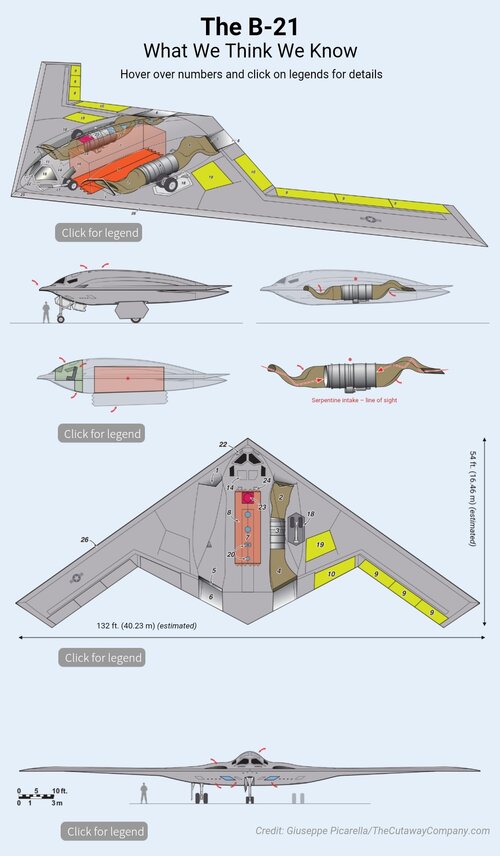
FighterJock
ACCESS: Above Top Secret
- Joined
- 29 October 2007
- Messages
- 5,594
- Reaction score
- 5,919
So the B-21 only has a single weapons bay, I never fully belived it before I saw the graphic especially given what the internet can be like with photoshop these days.
We don't truly know how many bays it has, though I think the predominant opinion has always been that it had a single B-2 sized bay given the smaller size and more narrow separation of the engines. Certainly that is my feeling. USAF has however stated that the warload was to be 30,000 lbs rather than the 20,000 Bill Sweetman estimates, though in practice I suspect 20,000 is the actual working war load and 30,000 is only with a GBU-57.
Scott Kenny
ACCESS: USAP
- Joined
- 15 May 2023
- Messages
- 11,531
- Reaction score
- 14,126
Not to mention ONLY TWO ENGINES, even if they are a pair of F135s sans afterburners.We don't truly know how many bays it has, though I think the predominant opinion has always been that it had a single B-2 sized bay given the smaller size and more narrow separation of the engines.
I think you can stuff 24x 1kpdrs in there with the SBA, but it's ~16klbs with 8x 2kpdrs. 30k with the GBU-57.Certainly that is my feeling. USAF has however stated that the warload was to be 30,000 lbs rather than the 20,000 Bill Sweetman estimates, though in practice I suspect 20,000 is the actual working war load and 30,000 is only with a GBU-57.
Assuming the rack systems of a B-2 and only one bay, most loads would be 20k ish. MOP would be more. A rack system with ~100 SBD II would be 20,000 but SDB would be 30,000. The B-2 can apparently carry a pair of GBU-57, so it apparently can sacrifice fuel for a heavier than nominal load and I’d expect the B-21 to be able to make the same sacrifice. But roughly speaking, half a B-2 seems like a good rule of thumb based on what little we know.
Scott Kenny
ACCESS: USAP
- Joined
- 15 May 2023
- Messages
- 11,531
- Reaction score
- 14,126
That's what I've been assuming from the beginning, that the B-21 is really a medium bomber with strategic range. One bay, with an AGM86B length.Assuming the rack systems of a B-2 and only one bay, most loads would be 20k ish. MOP would be more. A rack system with ~100 SBD II would be 20,000 but SDB would be 30,000. The B-2 can apparently carry a pair of GBU-57, so it apparently can sacrifice fuel for a heavier than nominal load and I’d expect the B-21 to be able to make the same sacrifice. But roughly speaking, half a B-2 seems like a good rule of thumb based on what little we know.
That's what I've been assuming from the beginning, that the B-21 is really a medium bomber with strategic range. One bay, with an AGM86B length.
Yes, most likely. In particular, I think since the B-21 was specifically designed for the Pacific, payload was exchanged for range. I would bet my annual income that it has a B-52 (pre re-engine) level of range or better. Lighter airframe from composite advancements, high bypass twin fans instead of four more military types, better aerodynamic high altitude efficiency, the previously mentioned trade off of weapons for total MTOW, etc.
Last edited:
Not to mention ONLY TWO ENGINES, even if they are a pair of F135s sans afterburners.
I think you can stuff 24x 1kpdrs in there with the SBA, but it's ~16klbs with 8x 2kpdrs. 30k with the GBU-57.
Minor quibbles - PW9000 is not know to have any lineage to the F135; it is supposed to be a "militarized" engine based on the commercial geared PW1000 series high bypass turbo fans. The gearing arrangement allows the bypass compressors to spin at a different, more optimal speed then the engine core. Though Bill Sweetment specifically describes the PW9000 as "medium bypass" with a "direct drive". In any case, if he is correct about the engine (which seems likely; a higher bypass would have huge advantages if it could be made to work) then there isn't much relation to F135. I'm glad he mentioned the F118 in the B-2. I always wondered why a more fighter type engine was used and apparently the answer is concerns about flow distortion due to the complexity of the intake/exhaust flow. Apparently now they can model these sufficiently well such that the ducting can supply a more uniform flow?
AFAIK the Smart Bomb Assembly Rack is limited to 20 pieces of ordnance. It has only been pictured with mk82s to the best of my knowledge, though I have seen it stated that on this forum that it is capable of carrying 1000 lb ordnance as well. AFAIK Mk83 has been phased out of USAF usage though. I would suspect that the future SiAW will be designed for this rack or a modified version of it. I would also guess that some kind of SDB specific rack with a capacity of ~100 weapons would also be integrated. Large numbers of PGM glide bombs are a natural fit to a high altitude stealth bomber: it provides a large degree of stand off with a low IR signature release (compared to a powered missile) while maximizing aim points.
- Joined
- 16 April 2008
- Messages
- 9,600
- Reaction score
- 14,470
AFAIK the Smart Bomb Assembly Rack is limited to 20 pieces of ordnance. It has only been pictured with mk82s to the best of my knowledge, though I have seen it stated that on this forum that it is capable of carrying 1000 lb ordnance as well.
This guy?
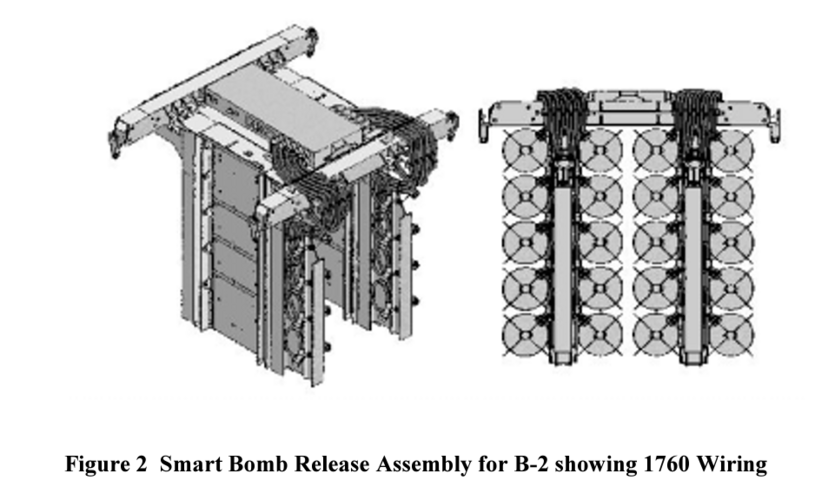
This drawing is not totally representative, BTW. (I think it shows dumb bombs, but JDAM fins are bigger). Check real life, below.
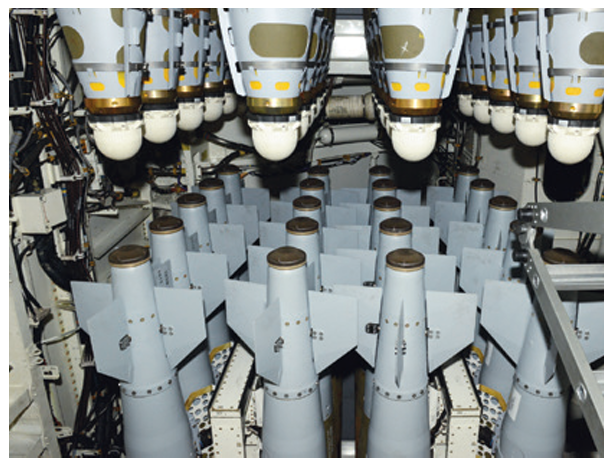
It would be tricky to rig with 1,000 lb JDAMs, given the tight spacing. They're already overlapping fins on the middle of the rack with 500-lb JDAMs. But maybe with more of a stagger and only two weapons on each side of the center section?
And frankly, the terminal effects aren't THAT different -- 500-lb for when you want to hit lots of aim points and 2000-lb for when you need heavier impacts seems like a fine enough distinction.
The real question IMO is about SDB. Stacking four nose to tail requires a very long bay, over 7.2 meters. I'm not sure what geometry you need to fit 100 in a 6.2-meter (MOP-sized) bay.
This guy?
View attachment 709619
This drawing is not totally representative, BTW. (I think it shows dumb bombs, but JDAM fins are bigger). Check real life, below.
View attachment 709620
It would be tricky to rig with 1,000 lb JDAMs, given the tight spacing. They're already overlapping fins on the middle of the rack with 500-lb JDAMs. But maybe with more of a stagger and only two weapons on each side of the center section?
And frankly, the terminal effects aren't THAT different -- 500-lb for when you want to hit lots of aim points and 2000-lb for when you need heavier impacts seems like a fine enough distinction.
The real question IMO is about SDB. Stacking four nose to tail requires a very long bay, over 7.2 meters. I'm not sure what geometry you need to fit 100 in a 6.2-meter (MOP-sized) bay.
At 70 inches, three SDBs should fit nose to tail in 17.5 feet, leaving three feet to spare in the B-2 bomb bay. Possibly enough? It would have to go through modeling and separation testing; the aerodynamics might not support three SBA back to back. Also I assume if you built a custom rack for them you could stack more than five vertically, since they are less than half the diameter of a Mk82. I've seen several articles indicating that the USAF thought it could fit 192-216 GBU-39s into a B-2; I unfortunately can't find the original USAF source for that right now. That is where I get the ~100 number, and weight wise, that would probably be the upper limit: 20,000 lbs of GBU-53 or 30,000lbs of GBU-39.
As far as I know the SDB was never integrated with B-2, though I have seen at least one picture with a four round launcher on CSRL. I think someone posted in the B-2 thread that SDB integration was postponed in expectation of integrating the SDB-II vice the SDB-I, and Stormbreaker only entered service in the last year or two with the F-15E. Maybe B-2s won't ever be integrated, but presumably B-21 would carry it.
- Joined
- 28 January 2008
- Messages
- 1,015
- Reaction score
- 2,194
They need a robust and responsive engine with no compressor stalls in any flight condition, this is not a hot rod. On the B-2 during flight test, we had inlet distortion but no compressor stalls at max AOA/max AOS with throttle slams from flight idle to TRT.Minor quibbles - PW9000 is not know to have any lineage to the F135; it is supposed to be a "militarized" engine based on the commercial geared PW1000 series high bypass turbo fans. The gearing arrangement allows the bypass compressors to spin at a different, more optimal speed then the engine core. Though Bill Sweetment specifically describes the PW9000 as "medium bypass" with a "direct drive". In any case, if he is correct about the engine (which seems likely; a higher bypass would have huge advantages if it could be made to work) then there isn't much relation to F135. I'm glad he mentioned the F118 in the B-2. I always wondered why a more fighter type engine was used and apparently the answer is concerns about flow distortion due to the complexity of the intake/exhaust flow. Apparently now they can model these sufficiently well such that the ducting can supply a more uniform flow?
AFAIK the Smart Bomb Assembly Rack is limited to 20 pieces of ordnance. It has only been pictured with mk82s to the best of my knowledge, though I have seen it stated that on this forum that it is capable of carrying 1000 lb ordnance as well. AFAIK Mk83 has been phased out of USAF usage though. I would suspect that the future SiAW will be designed for this rack or a modified version of it. I would also guess that some kind of SDB specific rack with a capacity of ~100 weapons would also be integrated. Large numbers of PGM glide bombs are a natural fit to a high altitude stealth bomber: it provides a large degree of stand off with a low IR signature release (compared to a powered missile) while maximizing aim points.
- Joined
- 27 December 2005
- Messages
- 17,734
- Reaction score
- 26,296
The engine was expected to be either PW9000 or F135. No-reheat F135 seemed the easier option, but if PW9000 is apparently a reasonably simple adaptation of a commercial core, then it makes sense, fuel burn would be substantially better. F135 would mean more theatre, medium bomber class, while PW9000 suggests strategic range possibilities.
- Joined
- 3 June 2011
- Messages
- 18,326
- Reaction score
- 12,193
Any recent details on the PW9000?The engine was expected to be either PW9000 or F135. No-reheat F135 seemed the easier option, but if PW9000 is apparently a reasonably simple adaptation of a commercial core, then it makes sense, fuel burn would be substantially better. F135 would mean more theatre, medium bomber class, while PW9000 suggests strategic range possibilities.
Any recent details on the PW9000?
I think it went dead or black a decade ago. I can’t find any modern references to it outside this most recent article. But that guy usually knows his stuff, so I’d tend to believe it.
- Joined
- 1 April 2006
- Messages
- 11,373
- Reaction score
- 10,198
Scott Kenny
ACCESS: USAP
- Joined
- 15 May 2023
- Messages
- 11,531
- Reaction score
- 14,126
I'm expecting the B-21 to have a longer bay than the usual CSRL. ALCM length, not SRAM length. So there is space for hypersonics.The real question IMO is about SDB. Stacking four nose to tail requires a very long bay, over 7.2 meters. I'm not sure what geometry you need to fit 100 in a 6.2-meter (MOP-sized) bay.
- Joined
- 6 August 2007
- Messages
- 3,883
- Reaction score
- 5,902
Whatever the grey blob is, it's been there since at least the 4th of October. It appears to be about the same size as a B-2, so it may be the STA rather than the B-21. Regardless, the area where it is parked is visible from public land.
I am surprised various Instagram persons have not captured and posted video etc. of the engine runs at the least.
I am not all that surprised the shouty internet "journalists" have not left their keyboards to get photos or write stories with firsthand experiences.
- Joined
- 16 April 2008
- Messages
- 9,600
- Reaction score
- 14,470
I'm expecting the B-21 to have a longer bay than the usual CSRL. ALCM length, not SRAM length. So there is space for hypersonics.
CSRL(aka Common Rotary Launcher, aka Common Missile Launcher) is the ALCM launcher, and it is about 6.3 meters long, roughly the same length as a MOP (probably sized the other way around, of course -- MOP had to fit in the space of a CSRL.)
As far as I can tell, the same CSRLs (maybe with minor differences) are used in the B-52 and B-2 and were used in the B-1 back when it carried ALCM. There's also a short rotary launcher for SRAM, JSOW, etc. that only fits in the B-1.
CSRL(aka Common Rotary Launcher, aka Common Missile Launcher) is the ALCM launcher, and it is about 6.3 meters long, roughly the same length as a MOP (probably sized the other way around, of course -- MOP had to fit in the space of a CSRL.)
As far as I can tell, the same CSRLs (maybe with minor differences) are used in the B-52 and B-2 and were used in the B-1 back when it carried ALCM. There's also a short rotary launcher for SRAM, JSOW, etc. that only fits in the B-1.
What is the designation of the B-1 rotary?
Are we really thinking they let this get caught by a satellite? Unless this is the start of its path fully into the public eye.Whatever the grey blob is, it's been there since at least the 4th of October. It appears to be about the same size as a B-2, so it may be the STA rather than the B-21. Regardless, the area where it is parked is visible from public land.
I am surprised various Instagram persons have not captured and posted video etc. of the engine runs at the least.
I am not all that surprised the shouty internet "journalists" have not left their keyboards to get photos or write stories with firsthand experiences.
- Joined
- 6 August 2007
- Messages
- 3,883
- Reaction score
- 5,902
Are we really thinking they let this get caught by a satellite? Unless this is the start of its path fully into the public eye.
They are doing engine runs, soon they will be doing taxi tests and then it will be first flight. All of this is/will be in full view of the public.
Scott Kenny
ACCESS: USAP
- Joined
- 15 May 2023
- Messages
- 11,531
- Reaction score
- 14,126
Oh? I thought that the CSRL was the shorter length used by the B-1. My bad.CSRL(aka Common Rotary Launcher, aka Common Missile Launcher) is the ALCM launcher, and it is about 6.3 meters long, roughly the same length as a MOP (probably sized the other way around, of course -- MOP had to fit in the space of a CSRL.)
As far as I can tell, the same CSRLs (maybe with minor differences) are used in the B-52 and B-2 and were used in the B-1 back when it carried ALCM. There's also a short rotary launcher for SRAM, JSOW, etc. that only fits in the B-1.
- Joined
- 16 April 2008
- Messages
- 9,600
- Reaction score
- 14,470
What is the designation of the B-1 rotary?
Apparently it's the Multi-Purpose Rotary Launcher.

USAF TO UPGRADE B-1B LANCER'S ROTARY LAUNCHER - The Aviation Geek Club
USAF TO UPGRADE B-1B LANCER'S ROTARY LAUNCHER
- Joined
- 1 April 2006
- Messages
- 11,373
- Reaction score
- 10,198
Yes, it quite may be homeless STA with color variations due to different lightning conditions.Hmmm.....
- Joined
- 3 June 2011
- Messages
- 18,326
- Reaction score
- 12,193
No MOP for the B-21.Interactive Graphic: Design Features Likely on The B-21 Raider
https://aviationweek.com/defense-sp...ve-graphic-design-features-likely-b-21-raider
Screenshot:
View attachment 709567
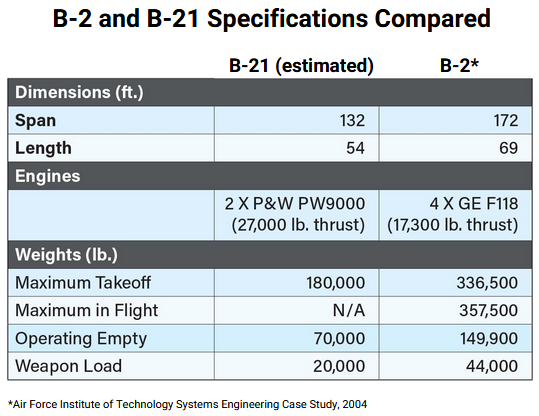
(Of course the B-2 can carry 2 at 60,000lbs+ so who knows how accurate the table is.)
- Joined
- 16 April 2008
- Messages
- 9,600
- Reaction score
- 14,470
No MOP for the B-21.
View attachment 709692
(Of course the B-2 can carry 2 at 60,000lbs+ so who knows how accurate the table is.)
I would not credit that table much.
Bear in mind that the MOP displaces the rotary launcher, which itself weighs a fair bit but is not usually counted toward the weapon load of the aircraft.
No MOP for the B-21.
View attachment 709692
(Of course the B-2 can carry 2 at 60,000lbs+ so who knows how accurate the table is.)
Yeah, as you point out, technically the B-2 shouldn't be able to carry 2 MOPs either given its nominal war load. I assume that when this ordnance is carried the plane is loaded with less fuel. The USAF has previously explicitly stated that B-21 would have 30,000+ payload; I'd be very surprised if it couldn't carry GBU-57 at least with reduced fuel. 20,000 to me seems more like what a typical load might consist of - eight 2000# class weapons, four 5000# type penetrators, forty 500# class weapons, ~100 SDB II, etc.
The other thing is that were those (estimated) numbers to be correct, that would point to a fuel fraction of ~0.5
FighterJock
ACCESS: Above Top Secret
- Joined
- 29 October 2007
- Messages
- 5,594
- Reaction score
- 5,919
I would not belive those figures either, the best we can all do is wait and see what the true figures are concerning the B-21s maximum take of weight when the USAF releases the true figures eventually. Though I fear that is going to be a long wait.
- Joined
- 2 August 2006
- Messages
- 3,255
- Reaction score
- 1,527
I thought the USAF was working on a new rocket powered munition to replace the MOP, that would have the same hitting power, but in a smaller package? I was assuming that that is what the B-21 would carry for such a mission if required.
FighterJock
ACCESS: Above Top Secret
- Joined
- 29 October 2007
- Messages
- 5,594
- Reaction score
- 5,919
Have you any further info on the new rocket powered munition? I like the sound of that Sundog.
I've not heard of a MOP replacement but it wouldn't surprise me if one is being worked on. But new variants of the GBU-57 are still being produced and the B-21 design was frozen in 2018, so I'd be surprised if it wasn't included as part of the B-21 requirements and retained the capability, even if a replacement weapon is in development.
ETA: from just last year -
ETA: from just last year -
- Joined
- 16 April 2008
- Messages
- 9,600
- Reaction score
- 14,470
I've not heard of a MOP replacement but it wouldn't surprise me if one is being worked on. But new variants of the GBU-57 are still being produced and the B-21 design was frozen in 2018, so I'd be surprised if it wasn't included as part of the B-21 requirements and retained the capability, even if a replacement weapon is in development.
ETA: from just last year -
Back around 2010, there was a Next-Generation Penetrator RFP for a weapon described as being about a third the size of MOP (so, ~9000 lbs) to fit in smaller, more affordable aircraft, including the LRS aircraft. But I can't tell what happened after that. By 2011, there was a focus on a High-Velocity Penetrating Weapon, a 2000-lb rocket-assisted weapon to match the GBU-28 for the F-35 Now we have the GBU-72, a 5000-lb GPS weapon.
Similar threads
-
USAF to Retire B-1, B-2 in Early 2030s as B-21 Comes On-Line
- Started by flateric
- Replies: 323
-
-
-
-


